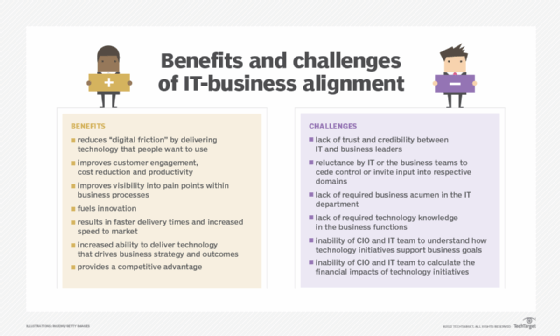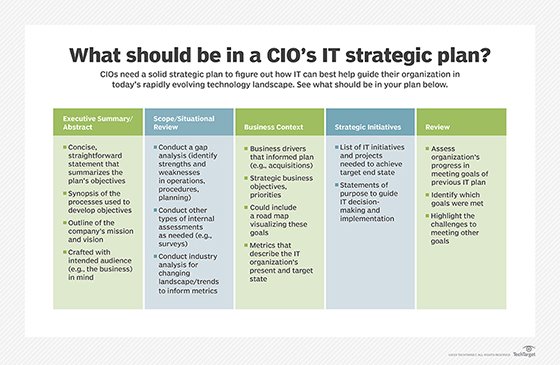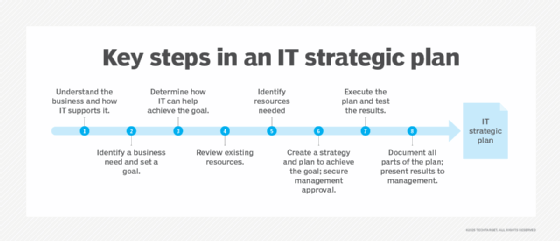What is an IT strategic plan (information technology strategic plan)?
An IT strategic plan is a document that details the comprehensive technology-enabled business management processes an organization uses to guide operations. It serves as a guide to IT-related decision-making, with IT tasks prioritized and implemented using the plan as a framework.
The plan also helps guide an organization as it formulates its overall IT strategy. While an IT strategy focuses on how IT will help the business succeed, an IT strategic action plan is an IT roadmap to help the business implement those strategies.
Why an IT strategic plan is useful
The plan outlines areas where IT can contribute business value and where an organization can gain a competitive advantage by making the best use of technology resources.
The objectives outlined in an organization's IT strategic plan should align with the organization's strategic goals and mission, but accommodate new business priorities and technologies that could drive business growth.
It's also important for an IT organization's teams to know their priorities and identify the IT projects that the business should invest in. The plan outlines what has to be done in what priority and how the plan's success will be measured.

Pros and cons of IT strategic plans
While it is certainly possible to manage an IT organization without the use of strategic plans, senior company leaders typically expect such plans to be developed and presented. Among their many benefits is that they provide a roadmap for how IT will evolve during the current and upcoming calendar years.
Since IT is often one of the largest budgetary items, strategic plans help identify where funding will be needed and how the company can benefit. Plans can identify how resources will be used, potential risks and threats to IT operations, costs that are expected and possibly unplanned, opportunities for innovation, communications among different stakeholders, and metrics for measuring performance.
Conversely, developing IT strategic plans can be time-consuming, complex and costly, requiring many different resources. They might face resistance to change from within the organization, and might not always be able to anticipate changes and developments in technology. Strategic plans are also living documents; they must be regularly reviewed and updated, which can again require time and resources.

Components of an IT strategic plan
As noted in Figure 2, an IT strategic plan should outline a mission statement that includes what it plans to achieve and how the IT strategy relates to the organization's overall business and strategic objectives. Often, creating an effective IT strategic plan starts with reviewing the organization's strategic plan, which identifies areas where technology use can improve operations.
The IT strategic plan should include a SWOT analysis of its strengths, weaknesses, opportunities and threats to identify both internal and external factors that can affect IT's ability to contribute to an organization's success.
The strategic planning process helps organizations analyze the IT department's progress in achieving its goals and next steps to fulfill them. The department can then identify barriers and the resources needed for this process.
The SWOT analysis also helps organizations identify any existing technological assets that might be obscuring a previously unknown competitive advantage and that the organization should consider investing in to capitalize on the benefit.
The IT strategic plan must be clear about its goals, including a list of technology investments that the IT department deems a priority to contribute to the organization's success. Finally, the plan should also include evaluating the company's current IT budget and allocating project-specific resources and responsibilities to meet targeted objectives.
Outline of an IT strategic plan
Many different strategic plan structures and formats are available. Each plan must be tailored to the organization's business requirements and how IT supports them. Here is a starting point.
- Executive summary. Provides an overview of the plan, its aims and what is needed to achieve them.
- Mission and vision statements. Provides a high-level view of the plan that addresses both business and technology issues.
- Situation analysis. Examines the business issue, how it is currently managed and where it needs to be to satisfy management; assesses the financial, operational, competitive, risk, security, people and reputational issues.
- Business needs assessment. Focuses on the business unit that has the requirement and what it needs to achieve its specific business goals.
- IT resources assessment. Examines resources currently available to determine if they are sufficient to achieve the defined goals; if not, identifies the resources needed.
- SWOT analysis. The strengths, weaknesses, opportunities and threats analysis provides a more detailed analysis of what IT needs to achieve the business requirements.
- IT strategy definition. Describes the technology, procedures and staffing needed to achieve the business goals; ideally, defines the final results that the plan aims to achieve.
- Processes needed to achieve the strategy. Details the actions needed to move from strategic plan approval to plan execution and delivery.
- Summary of next steps. Describes what is needed once management has approved the plan, including staffing, resources, funding and the development of a project plan.
The preceding outline is a suggestion. Many tools and resources are available to prepare an IT strategic plan. One way to proceed quickly is to search for existing IT strategic plans. Plan templates and software applications are also available to help facilitate plan development. If the organization already has a format and structure for strategic plans, that template should be used.
Figure 3 shows the fundamental activities in developing a strategic plan, beginning with understanding the business and its specific requirements.

Knowledge of the business and how IT supports it represents the starting point. In discussions with business leaders and subject matter experts, the IT planning team identifies a specific business need, such as providing a better customer experience when using online access to company resources.
IT leaders, engineers, research and development staff, software designers, network engineers and others collaborate on ways to achieve business requirements. Existing resources must be evaluated for their utility, and new resources must be identified that can be added.
The IT strategic planning team gathers all preliminary data on existing and anticipated resources, funding requirements, staffing, and other factors to prepare a strategy for achieving the business requirement. Assuming management approves the plan, a project plan is subsequently created and approved to execute the activities integral to the business results.
Once the plan has been completed, performance testing and validation occur to make sure that the results are satisfactory to the business units. Each of the activities in this sequence must be carefully documented as part of the strategic plan and subsequent project plans.
Examples of IT strategies
Consider three examples of how a business need is turned into an IT strategy:
- An organization that sells a variety of products in brick-and-mortar stores wants to transition some of those activities to online customer interaction. A customer relationship management system is recommended to facilitate the desired transition.
- A university decides to have its students interact with university services entirely online. Existing online applications are deemed unsuitable; new apps must be developed so that students can log in to all available university services on their smartphones.
- A manufacturing company handles most of its warehouse activities with legacy technology supporting inventory, order processing, parts location, packing and shipping. A warehouse management system that interfaces with existing business systems is an option that will satisfy the business requirements.
Once the specific business need is identified, IT teams examine various options that can provide a solution. These initiatives and many others are consolidated into a formal IT strategic plan.
Who is responsible for an IT strategic plan?
When examining how the entire IT organization operates and what it might need to better support the business, the chief information officer and possibly the chief technology officer will take the lead. While the CTO might assist the CIO from a technology perspective, the CIO will examine how information technology holistically supports the entire organization.
These individuals typically work closely with business leaders and key departments such as finance, budget, human resources and legal when framing an IT strategy. Completed strategic plans must be agile enough to adapt to changes in business strategy and technology, the industry and marketplace, skill sets of personnel, and financial and budgetary issues.
Enterprise-wide vs. business unit strategic plans
As noted earlier, IT strategic plans can be structured around a variety of business requirements. Enterprise IT strategic plans are often designed for three- to five-year time frames and include a year-by-year view of what the business is likely to need and the IT resources required to satisfy it.
Business unit IT strategic plans typically address specific needs that business units have identified so that they can achieve their business objectives. These might be on an ad hoc basis or included in an overall enterprise IT strategic plan, if knowledge of the business unit requirements is available.
Medium to large IT organizations can process dozens of strategic plans during a calendar year. Some might be simple and focused on a specific business issue, while others, including the overall enterprise IT strategic plan, will be ongoing activities. IT senior leadership must determine if a specific business unit's request for assistance requires a strategic plan.
IT strategic plan development tools
Finding and reviewing existing IT strategic plans can help support plan development, so long as the plans being evaluated can be leveraged into a suitable product. If the organization has its own established strategic plan process, that should be followed.
According to research, here is a list of some well-known IT strategic plan development tools:
- Asana. Project management and strategic planning.
- ClickUp. Project management tools.
- Hive. Project management and strategic planning tools; supports teams.
- Jira. Jira is used for project management and strategic planning.
- Miro. IT strategic plan development tools.
- Monday.com. Project management tool that supports strategic planning.
- Planview. Suite of products for strategic planning, project management and other activities.
- Smartsheet. Project and work management support using spreadsheet technology.
- Trello. Project management tool.
- Whatfix. IT strategic plan development tools.
- Wrike. Project management and strategic planning software.
Many of the products listed address project management primarily and strategic planning as a secondary feature. Gartner provides guidance and insights on IT strategic plan development. The major cloud service providers -- Amazon Web Services, Google Cloud and Microsoft Azure -- are also worth investigating for strategic plan tools.
The effect of AI on IT strategic planning
AI technology can augment IT strategic plan development through enhanced analytics for more insightful planning, better predictive capabilities, improved data gathering, increased automation of various functions and greater focus on risk in the planning process. AI can also enhance project management, a key outcome of strategic planning.
Information technology is a key part of developing an effective strategic plan. Look at these eight free IT strategic planning templates that can help make IT a driving force in a business. Learn how to assess an organization's needs and implement a technology strategy and see how to set business goals in these step-by-step guides.







